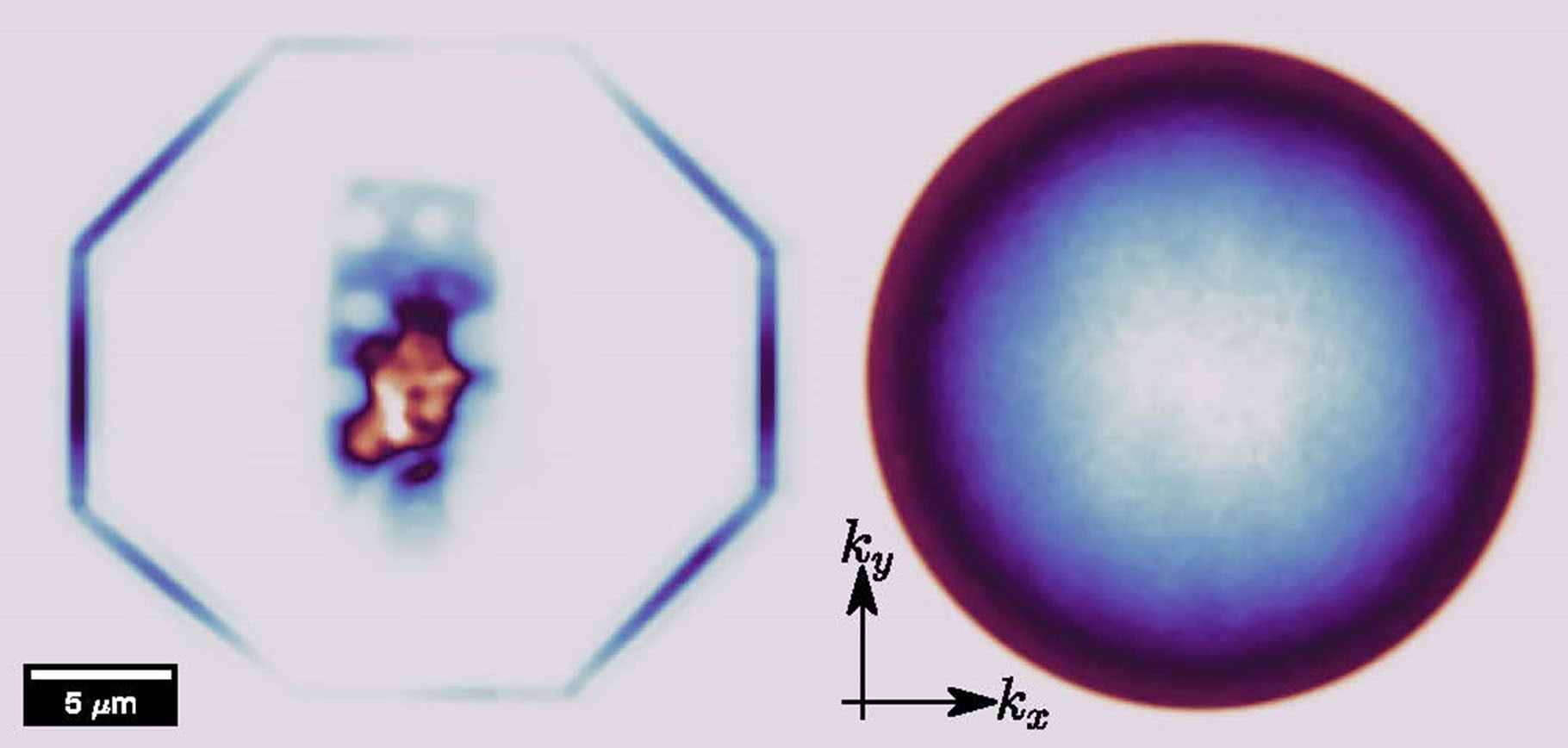The US Naval Research Laboratory (NRL), in partnership with Kansas State University, reported the development of slab waveguides made of the two-dimensional material hexagonal boron nitride. This achievement has been documented in the journal Advanced Materials.
 Real-space (left) and Fourier space (right) photoluminescence image of a hexagonal boron nitride waveguide. The real-space image shows where photoluminescence is emitted from within the sample, while the Fourier space image depicts the angle of the emitted light. Image Credit: Nicholas Proscia
Real-space (left) and Fourier space (right) photoluminescence image of a hexagonal boron nitride waveguide. The real-space image shows where photoluminescence is emitted from within the sample, while the Fourier space image depicts the angle of the emitted light. Image Credit: Nicholas Proscia
Two-dimensional (2D) materials can be mechanically separated into monolayers. The weak interlayer attractions, or van der Waals attraction, enable the layers to be separated using the so-called “Scotch tape” approach. The most well-known 2D substance is graphene, a semimetallic material composed of a single sheet of carbon atoms.
Other 2D materials, such as semiconducting transition metal dichalcogenides (TMDs) and insulating hexagonal boron nitride (hBN), have recently received interest. When reduced to near-monolayer thickness, 2D materials exhibit unique nanoscale features that make them intriguing for the development of atomically thin electronic and optical components.
We knew using hexagonal boron nitride would lead to outstanding optical properties in our samples, none of us expected that it would also act as a waveguide. Since hBN is used so widely in 2D material–based devices, this novel usage as an optical waveguide potentially has wide-ranging impacts.
Samuel Lagasse, PhD, US Naval Research Laboratory
Graphene and TMD monolayers are extremely sensitive to their surroundings. To safeguard these materials, researchers encapsulated them in a passivating layer. This is where hBN comes into play: layers of hBN may “screen” contaminants near graphene or TMD layers, resulting in remarkable characteristics. In recent NRL-led work, the thickness of hBN around a light-emitting TMD layer was precisely tailored to accommodate optical waveguide modes.
NRL researchers meticulously built stacks of 2D materials known as “van der Waals heterostructures.” The stacking of these heterostructures allows them to have specific characteristics. Slabs of hBN were wrapped around single layers of TMDs, such as molybdenum diselenide or tungsten diselenide, which emit light in the visible and near-infrared.
The thickness of the hBN slabs was carefully calibrated so that the emitted light was trapped within and waveguided. When light waveguides reach the edge of the hBN, they scatter and can be observed using a microscope.
The difficulties associated with optical measurements of 2D TMDs prompted the study. When laser light is focused on TMDs, particles called excitons are produced. Most excitons produce light outside of the TMD plane; however, an elusive kind of exciton known as a “dark” exciton occurs in some TMDs that emit within the TMD plane. NRL’s slab waveguides catch light from dark excitons, allowing optical studies.
Lagasse added, “2D materials have exotic optoelectronic properties that will be useful to the Navy. A large challenge is interfacing these materials with existing platforms without damaging them–these boron nitride waveguides are a step towards that realization.”
To characterize the hBN waveguides, NRL researchers employed two special optical microscopes. One configuration allows researchers to spectroscopically resolve photoluminescence emitted from various locations along the waveguide. The other configuration allowed them to observe the angular dispersion of the emitted light.
NRL researchers also created three-dimensional electromagnetic simulations of the waveguides. The modeling results give a toolkit for creating future 2D devices using slab waveguides.
Journal Reference:
LaGasse, S. W., et al. (2024) Hexagonal Boron Nitride Slab Waveguides for Enhanced Spectroscopy of Encapsulated 2D Materials. Advanced Materials. doi:10.1002/adma.202309777